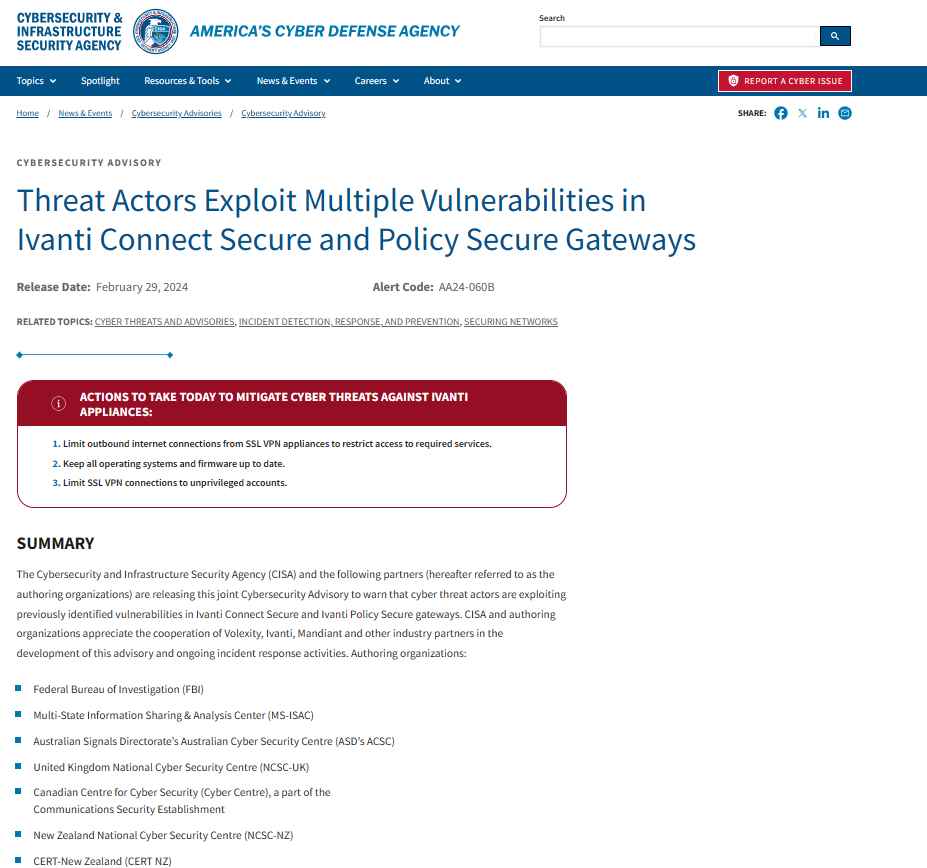In a significant cybersecurity incident, the Cybersecurity and Infrastructure Security Agency (CISA) was breached last month due to vulnerabilities in Ivanti software products. This breach underscores the ongoing threat data breaches pose to businesses, government agencies, and critical infrastructure, emphasizing the importance of robust cybersecurity measures.
The Incident at CISA
CISA, the agency responsible for protecting the United States’ critical infrastructure, fell victim to a cyberattack facilitated by vulnerabilities in Ivanti’s Connect Secure and Policy Safe products. These products, integral to many organizations’ IT infrastructure, had been targeted by various hacking groups. Since January, Ivanti had issued patches for five critical security vulnerabilities, but attackers exploited these known flaws before many organizations could apply the patches.

A new threat actor, Magnet Goblin, specialized in exploiting these vulnerabilities, highlighting the evolving cyber threat landscape where attackers demonstrate increased speed and sophistication. Upon detecting suspicious activity, CISA promptly took two compromised systems offline, although the specific systems and the extent of the breach remain undisclosed.
The Exploitation of Ivanti Vulnerabilities
The breach involved the compromise of two vital CISA systems: the Infrastructure Protection Gateway and the Chemical Security Assessment Tool (CSAT). This breach exposed sensitive information about the interdependency of private-zone chemical protection measures and U.S. infrastructure, marking a serious security lapse.
The vulnerabilities exploited by the attackers were CVE-2023-46805, CVE-2024-21887, and CVE-2024-21893. These vulnerabilities allowed for remote code execution and unauthorized access, posing severe security threats. Despite Ivanti’s efforts to patch these vulnerabilities and issue warnings, the attackers’ persistence led to an increase in attacks directed toward the compromised gateways.
In response, CISA disconnected all federal civilian agencies in the U.S. from Ivanti products to prevent further exploitation until patches were applied. The agency also highlighted the limitations of Ivanti’s Integrity Checker Tool (ICT) in detecting compromises effectively, emphasizing the need for enhanced cybersecurity measures beyond relying solely on vendor tools.
Impact and Response
The breach has raised concerns about the security of sensitive industrial data within the affected systems. While CISA reassures that there is currently no operational impact, the potential ramifications of such breaches on national security are significant. The lack of detailed information about the attack, including whether data was accessed or stolen, underscores the necessity for heightened cybersecurity measures.
The breach of CISA due to vulnerabilities in Ivanti products serves as a stark reminder of the persistent risk posed by cyber attackers. It highlights the critical need for organizations to maintain visibility, engage in proactive cybersecurity planning, and act swiftly in response to incidents. This incident transcends organizational boundaries, raising national security concerns and emphasizing the importance of cybersecurity monitoring throughout the lifespan of all critical infrastructure.
This detailed account of the CISA breach due to Ivanti vulnerabilities underscores the pervasive nature of cyber threats and the critical importance of proactive cybersecurity practices, continuous monitoring, and swift incident response to safeguard critical infrastructure and sensitive information from malicious actors.
Information security specialist, currently working as risk infrastructure specialist & investigator.
15 years of experience in risk and control process, security audit support, business continuity design and support, workgroup management and information security standards.
